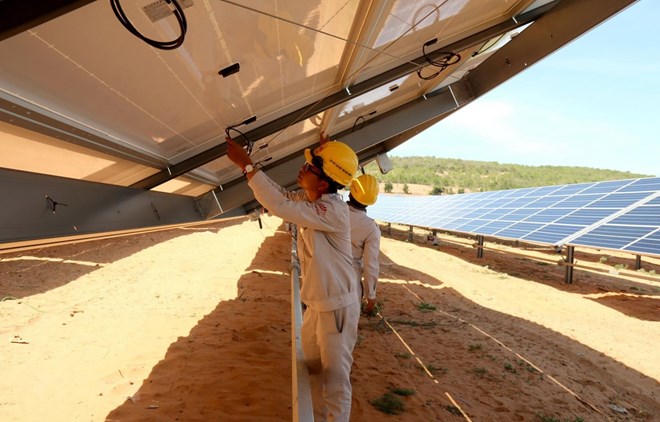 |
|
|
Vietnam has set a target of raising renewableenergy production from 58 billion kWh in 2015 to 101 billion kWh in 2020, 186billion kWh in 2030, and 452 billion kWh in 2050.
Under the renewable energy development strategy of Vietnamtowards 2030 with a vision to 2050 that was approved by the Government in 2015,the country aims to increase the ratio of electricity from renewable sourcesfrom 35 percent of total electricity output in 2015 to 38 percent in 2020 and43 percent in 2050.
According to Nguyen Van Vy, Vice Chairman of the VietnamEnergy Association, Vietnam has abundant potential for renewable energy thanksto a long coastline and weather conditions favourable for the development ofhydro, wind, solar, biomass, geothermal power and bio-fuel.
Research shows that Vietnam can generate about 8,000MW of small-scalehydropower, 200MW of wind power, 3,000MW of biomass power, and 35,000MW ofsolar power in 2030.
In the mainland, Vietnam can produce about 30GW of windpower, along with 100GW from offshore wind farms.
As of the end of 2018, Vietnam had 285 small hydropowerplants with total output of 3,322MW, along with 8 solar power plants with 243MWin total output and 10 biomass power plants (212MW).
The Vietnam Electricity has signed power purchase agreements(PPA) with more than 100 solar power projects, two of which have becomeoperational with combined capacity of 86MW.
So far, electricity generation from renewable sources,excluding medium- and large-scale hydro power plants), has accounted for 2.1percent of the country’s electricity output.
Do Duc Quan, Vice Director General of the Electricity andRenewable Energy Authority under the Ministry of Industry and Trade said thatas of June 2019, total installation capacity of solar, wind and biomassprojects reached about 2.5GW, and 2GW more of solar power will be added.
Quan said that in order to encourage renewable energydevelopment, the ministry has submitted to the Government proposals on variousmechanisms such as Feed-in-Tariff mechanism, as well as incentives forinvestors in access to credit, corporate income tax, land use, and PPAs.
Besides, experts suggested Vietnam should create a transparentinvestment environment and a clear policy roadmap with long vision to helpinvestors make decision on long-term investment, he added.
However, Quan pointed out that the rapid growth of renewableenergy recently has also created a number of challenges such as high investmentcost, pressure on electricity grid infrastructure and large demand for land.
According to a report of the Vietnam Electricity, renewableenergy development has also faced problems in the operation system. Due to alack of official guidelines on payments, the EVN has yet to purchasehouseholds’ rooftop solar power. Alongside, big investment is also anotherproblem.-VNA
 Vietnam has set a target of raising renewable energy production from 58 billion kWh in 2015 to 101 billion kWh in 2020, 186 billion kWh in 2030, and 452 billion kWh in 2050.
Vietnam has set a target of raising renewable energy production from 58 billion kWh in 2015 to 101 billion kWh in 2020, 186 billion kWh in 2030, and 452 billion kWh in 2050.